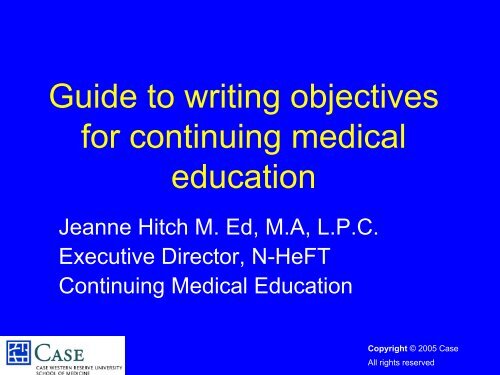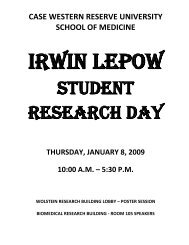Guides to Writing Objectives for CME - Case Western Reserve ...
Guides to Writing Objectives for CME - Case Western Reserve ...
Guides to Writing Objectives for CME - Case Western Reserve ...
You also want an ePaper? Increase the reach of your titles
YUMPU automatically turns print PDFs into web optimized ePapers that Google loves.
Guide <strong>to</strong> writing objectives<br />
<strong>for</strong> continuing medical<br />
education<br />
Jeanne Hitch M. Ed, M.A, L.P.C.<br />
Executive Direc<strong>to</strong>r, N-HeFT<br />
Continuing Medical Education<br />
Copyright © 2005 <strong>Case</strong><br />
All rights reserved
Purpose<br />
This guide serves as a resource <strong>to</strong> provide<br />
basic <strong>to</strong>ols <strong>for</strong> planning a learning activity that<br />
will help physicians apply medical advances<br />
in their day <strong>to</strong> day <strong>to</strong> day practice of medicine<br />
with the ultimate goal of improving health<br />
care.<br />
Our goal is <strong>to</strong> improve the quality of health<br />
care by improving the quality of medical<br />
education.
<strong>Objectives</strong> <strong>for</strong> this guide<br />
Goal<br />
Using this guide as a <strong>to</strong>ol, the planning committee will prepare<br />
effective activities <strong>to</strong> help physicians apply new advances in<br />
basic and clinical science <strong>to</strong> health care.<br />
When planning an activity the learner will be able <strong>to</strong><br />
– Recognize the role of objectives in the planning process<br />
– Determine the relationship between the needs assessment<br />
and objectives<br />
– Consider desired attributes <strong>for</strong> physicians<br />
– Identify the three elements of the ideal objective<br />
– Write clear objectives <strong>to</strong> direct the activity<br />
– Use this guide a <strong>to</strong>ol <strong>to</strong> prepare acceptable objectives <strong>for</strong><br />
sponsorship
<strong>Objectives</strong>, outcomes and the<br />
Mission of <strong>CME</strong><br />
The mission of The Continuing Education Program<br />
requires us <strong>to</strong> support the lifelong education of<br />
physicians. To do so medical educa<strong>to</strong>rs must<br />
understand how changes in society’s views of health<br />
and disease and changes in the organization,<br />
financing, and delivery of health care shape<br />
expectations of physicians. They must then use this<br />
understanding <strong>to</strong> in<strong>for</strong>m the design, content, and<br />
conduct of medical education programs. <strong>Objectives</strong><br />
guide the process by focusing on the desired<br />
outcomes.
What is the purpose of<br />
objectives?<br />
<strong>Objectives</strong> are an integral part of the<br />
activity development cycle. They<br />
provide the map <strong>to</strong> direct development<br />
of design, content, and conduct<br />
leading <strong>to</strong> a desired outcome.
What is an objective?<br />
An objective is a statement describing what the<br />
learner will be able <strong>to</strong> accomplish as a<br />
result of the instructional activity.<br />
Example: Given a ventriclogram and cath lab<br />
data of pressures, cardiac outputs and<br />
ejection fraction, identify aortic stenosis.
<strong>Objectives</strong> contain three parts<br />
1. a measurable verb<br />
2. the condition or context under which<br />
the behavior will occur<br />
3. the criterion of acceptable per<strong>for</strong>mance<br />
Mager RF. Preparing Instructional <strong>Objectives</strong><br />
2nd Ed. Belmont, CA, Lake Publishing Co. 1984
Expectations of physicians<br />
The American Association of Medical Colleges met<br />
with leaders of the medical education community<br />
in 1998 who reached consensus on four essential<br />
attributes required by physicians <strong>to</strong> meet society’s<br />
expectations of them in the practice of medicine.<br />
Report I Learning <strong>Objectives</strong> <strong>for</strong> Medical Student<br />
Education-Guidelines <strong>for</strong> Medical Schools
Essential attributes <strong>for</strong><br />
physicians<br />
Physicians must be altruistic.<br />
Physicians must be knowledgeable.<br />
Physicians must be skillful.<br />
Physicians must be dutiful.<br />
Report I Learning <strong>Objectives</strong> <strong>for</strong> Medical<br />
Student Education-Guidelines <strong>for</strong> Medical<br />
Schools AAMC/1998
Summary of attributes <strong>to</strong><br />
consider in the planning process<br />
Altruistic: demonstrate traits, attitudes, and values that<br />
underpin ethical and beneficent medical care<br />
Knowledgeable-recognize relevant scientific advances,<br />
especially in the disciplines of genetics and molecular<br />
biology<br />
Skillful-provide care <strong>to</strong> individual patients including<br />
accurate medical his<strong>to</strong>ry, relevant physical examination<br />
and appropriate diagnostic procedures, interpreting and<br />
managing lab and radiology in<strong>for</strong>mation, and seeking<br />
consultation when indicated. Utilize science and<br />
evidence <strong>to</strong> provide therapeutic options communicating<br />
honestly and objectively<br />
Dutiful - collaborate with other health professionals <strong>to</strong><br />
promote, maintain, and improve the health of individuals<br />
and populations<br />
Report I Learning <strong>Objectives</strong> <strong>for</strong> Medical Student<br />
Education-Guidelines <strong>for</strong> Medical Schools AAMC/1998
How do you measure<br />
achievement of these attributes?<br />
Although we know measuring outcomes<br />
determines whether or not objectives have<br />
been met, measuring attitudes and values<br />
is a challenge.<br />
To measure desired outcomes, look <strong>for</strong> a<br />
demonstration of the desired attributes<br />
within the context of the medical practice.
Where do we start?<br />
Global objectives support prospective<br />
participants’ choice of continuing<br />
medical education based on their<br />
1. perceived needs<br />
2. preferred learning methods<br />
3. practice setting
Activity Development Cycle<br />
Conduct learning<br />
activity<br />
Measure whether<br />
or not<br />
objectives were met<br />
Design learning<br />
activity<br />
<strong>to</strong> meet objectives<br />
Assess audience needs<br />
Develop learning objectives<br />
based on needs
How do we get objectives?<br />
1. Look at the whole picture first.<br />
2. Start at the end by selecting the goals<br />
or desired outcomes of your activity.<br />
3. Determine the learning gap between<br />
current practice and best practice by<br />
doing a needs assessment of the<br />
attributes as they relate <strong>to</strong> your<br />
activity:
Steps in the writing process<br />
Determine the desired outcomes<br />
Identify specific needs; per<strong>for</strong>m a gap<br />
analysis<br />
Write learning objectives <strong>to</strong> meet<br />
identified needs
Examples of desired<br />
outcomes<br />
Reduced mortality rates<br />
Reduced hospitalizations<br />
Improved quality of life<br />
Early recognition and treatment of disease<br />
Prevention of disease<br />
Satisfied patients<br />
Patient compliance<br />
Cost effective practice<br />
Health care <strong>for</strong> patients who are unable <strong>to</strong> pay<br />
Access <strong>to</strong> health care <strong>for</strong> members of traditionally<br />
underserved populations
Analyze the learning gap between<br />
desired outcomes and current<br />
practice<br />
Consider the desired physician<br />
attributes<br />
Per<strong>for</strong>m a needs assessment of<br />
attributes as they relate <strong>to</strong> your activity<br />
Write statements that reflect the<br />
achievement of the outcomes as a<br />
result of your activity
Physicians must be altruistic<br />
Sample global objectives<br />
Discuss threats <strong>to</strong> medical professionalism<br />
posed by the conflicts of interest inherent in<br />
various financial and organizational<br />
arrangements <strong>for</strong> the practice of medicine.<br />
Apply HIPPA regulations in support of<br />
compassionate treatment of patients, and<br />
respect <strong>for</strong> their privacy and dignity
Physicians must be altruistic<br />
Sample specific objectives<br />
Select appropriate diagnostic regimen <strong>for</strong> female<br />
patients at risk <strong>for</strong> heart disease<br />
Communicate with patients about treatment options <strong>for</strong><br />
breast cancer recognizing traditional and nontraditional<br />
modes of care<br />
Outline the elements of effective record keeping in<br />
compliance with local and national regulations<br />
Discuss the benefits and potential hazards of<br />
xenotransplantation
Physicians must be knowledgeable.<br />
Sample specific objectives<br />
When given a list of patients, identify with<br />
100% accuracy those patients <strong>for</strong> whom<br />
nutritional support is indicated.<br />
Diagram a simplified model of the crossbridge<br />
cycle and identify which step is<br />
associated with <strong>for</strong>ce production and which is<br />
impaired at low levels of ATP
Physicians must be skillful.<br />
Sample specific objectives<br />
Construct a disease management strategy <strong>for</strong><br />
patients with type 2 diabetes selecting from<br />
models proven <strong>to</strong> reduce hospitalizations<br />
Evaluate patient charts <strong>for</strong> documentation of<br />
patient education<br />
Apply latest advances in pain management <strong>to</strong><br />
ameliorate the suffering of patients in end stage<br />
cancer
Physicians must be dutiful.<br />
Sample specific objectives<br />
Promote healthy behaviors by counseling<br />
patients with obesity and their families <strong>to</strong><br />
set goals <strong>for</strong> lifestyle changes<br />
Apply the principles of evidence-based<br />
medicine and cost effectiveness in making<br />
decisions about the utilization of limited<br />
medical resources <strong>for</strong> patients in need of<br />
lung transplant
Action Verbs: Recall:<br />
Retrieve previously learned in<strong>for</strong>mation<br />
define<br />
identify<br />
list<br />
recall<br />
name<br />
recognize<br />
state<br />
label<br />
duplicate<br />
match<br />
memorize<br />
reproduce<br />
repeat<br />
record
Action Verb list: Comprehension<br />
Discover the meaning of in<strong>for</strong>mation<br />
classify<br />
cite<br />
convert<br />
describe<br />
detect<br />
discover<br />
discuss<br />
distinguish<br />
explain<br />
Give<br />
examples<br />
indicate<br />
identify<br />
inven<strong>to</strong>ry<br />
locate<br />
question<br />
report<br />
select<br />
sort<br />
summarize<br />
translate
Action Verb list: Application<br />
Use previously learned in<strong>for</strong>mation in new situations<br />
add<br />
apply<br />
calculate<br />
change<br />
choose<br />
compute<br />
demonstrate<br />
employ<br />
graph<br />
illustrate<br />
implement<br />
instruct<br />
per<strong>for</strong>m<br />
practice<br />
produce<br />
schedule<br />
show<br />
sketch<br />
solve<br />
teach<br />
use<br />
utilize
Action Verb list: Analysis<br />
Examine in<strong>for</strong>mation and break it in<strong>to</strong> its component parts <strong>to</strong><br />
identify motives or causes, make inferences, determine<br />
relationships, or draw conclusions<br />
analyze<br />
arrange<br />
breakdown<br />
categorize<br />
classify<br />
compare<br />
contrast<br />
deduce<br />
derive<br />
diagram<br />
distinguish<br />
differentiate<br />
discriminate<br />
examine<br />
infer<br />
inspect<br />
outline<br />
relate<br />
select<br />
separate<br />
solve<br />
specify<br />
subdivide<br />
utilize
Action Verb list: Synthesis<br />
Apply prior knowledge and skills <strong>to</strong> produce something new<br />
assemble<br />
combine<br />
compile<br />
compose<br />
construct<br />
create<br />
design<br />
devise<br />
develop<br />
diagnose<br />
experiment<br />
Formulate<br />
generate<br />
group<br />
hypothesize<br />
integrate<br />
invent<br />
manage<br />
modify<br />
organize<br />
plan<br />
prepare<br />
prescribe<br />
propose<br />
rearrange<br />
reconstruct<br />
reorganize<br />
revise<br />
rewrite<br />
set up<br />
synthesize<br />
trans<strong>for</strong>m<br />
write
Action Verb list: Evaluation:<br />
Make judgments on basis of given criteria<br />
appraise<br />
assess<br />
conclude<br />
criticize<br />
critique<br />
decide<br />
defend<br />
evaluate<br />
estimate<br />
grade<br />
interpret<br />
judge<br />
justify<br />
measure<br />
rank<br />
rate<br />
score<br />
support<br />
test<br />
value
Review<br />
Think about the in<strong>for</strong>mation you want<br />
conveyed, attitudes you want <strong>to</strong> promoted<br />
and behavior you want displayed<br />
Write with the attributes and the list of verbs<br />
as a guide including per<strong>for</strong>mance, criteria and<br />
condition (criteria and condition need not be<br />
stated directly if they are obvious)<br />
Remember since not all outcomes are<br />
concrete they can not all be measured
<strong>Objectives</strong> revisited<br />
You should now be able <strong>to</strong> do the following <strong>to</strong> plan<br />
your activity<br />
– Recognize the role of objectives in the planning<br />
process<br />
– Determine the relationship between the needs<br />
assessment and objectives<br />
– Consider desired attributes <strong>for</strong> physicians<br />
– Identify the three elements of the ideal objective<br />
– Write better objectives <strong>to</strong> direct your activity<br />
– Use this guide a <strong>to</strong>ol <strong>to</strong> prepare acceptable<br />
objectives <strong>for</strong> sponsorship
Your turn......<br />
Let us know if you have questions,<br />
suggestions or comments. We will be<br />
happy <strong>to</strong> help you develop your<br />
objectives as part of the activity<br />
planning process.<br />
jeanne.hitch@case .edu
For further reading:<br />
Anderson, L. & Krathwohl, D. A. Taxonomy <strong>for</strong> Learning,<br />
Teaching and Assessing: A Revision of Bloom’s taxonomy of<br />
Educa<strong>to</strong>nal <strong>Objectives</strong>. New York: Longman, 2001<br />
Mager RF. Preparing Instructional <strong>Objectives</strong> 2nd Ed. Belmont,<br />
CA, Lake Publishing Co. 1984.<br />
Report I Learning <strong>Objectives</strong> <strong>for</strong> Medical Student Education-<br />
Guidelines <strong>for</strong> Medical Schools AAMC/1998

















